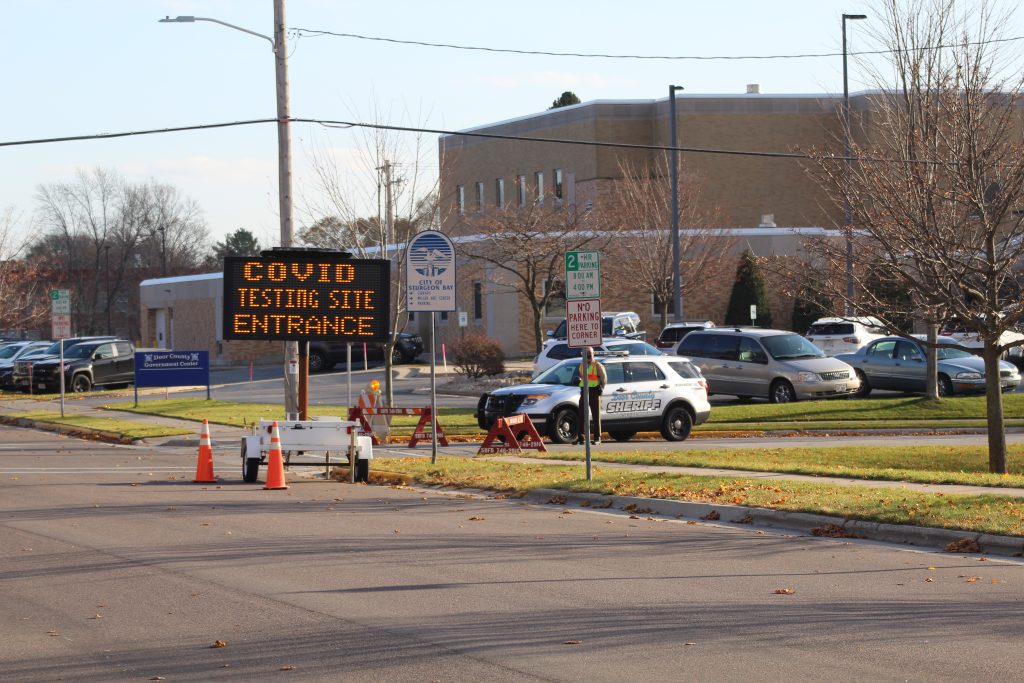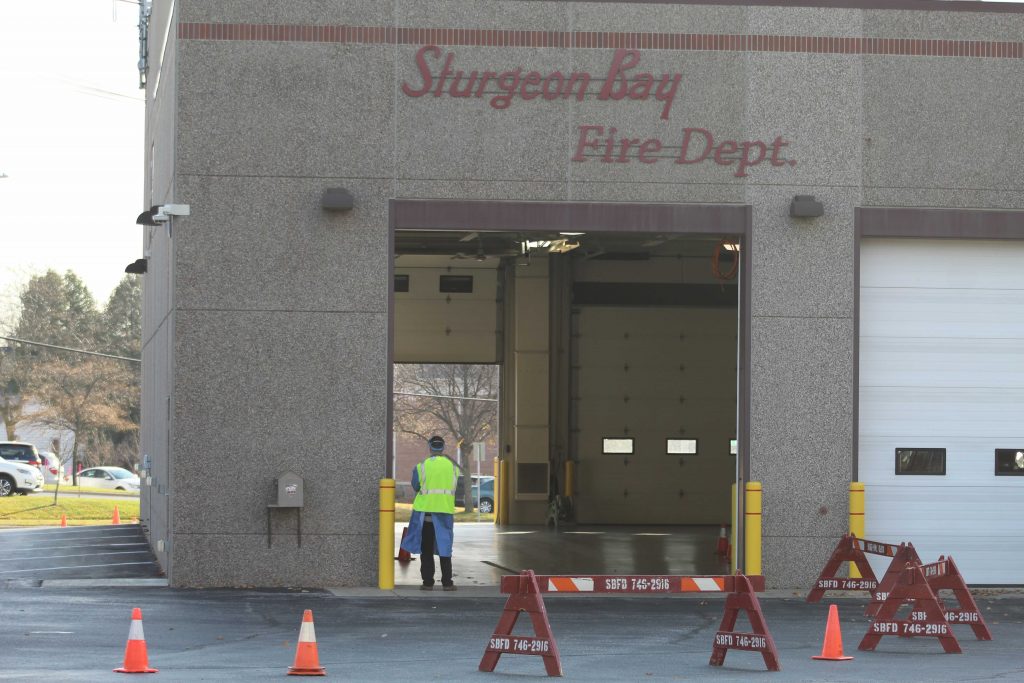
As cases of COVID-19 have skyrocketed in Door County this fall, the Door County Medical Center is “managing” amid a corresponding increase in hospitalizations, chief medical officer Dr. James Heise said last week.
Door County has seen more than 1,000 new cases of COVID-19 since Sept. 1, including more than 800 since Oct. 1. Emergency room visits and positivity rates in testing also have continued to rise, Heise said.
“We’re seeing some of the worst percent positives that we’ve seen since the beginning of this thing,” Heise said, adding that positivity rates right now are about 25 to 26 percent. “We really want that to be less than 5 percent.”
The Medical Center had four patients currently hospitalized due to COVID-19 as of Thursday, Heise said. It has had three to four COVID-19 patients hospitalized at a time on average for the past few weeks, he said.
With increased hospitalizations, the stress point for the Medical Center is not space, beds or equipment but staffing, Heise said.
“The problem, not just with us but with everyone, is having staff to care for people,” Heise said. “You only have so many nurses, you only have so many respiratory therapists.”
To maintain staffing levels, the Medical Center has had a surge plan in place since the spring, Heise said. Under that plan, Medical Center leaders on a daily basis look at the number of people hospitalized, both for COVID-19 and otherwise, and determine how best to shift staffing, if necessary.
In cases in which the Medical Center’s staffing capacity has been taxed, Heise said, leaders have deferred elective surgeries and postponed, by a week or so, some clinic appointments—such as Medicare annual wellness visits and annual physical exams—in order to free up staff for the hospital.
The most extreme case came in late October, Heise said, when the Medical Center had 31 patients overall hospitalized, and at around the same time had eight COVID-19 patients hospitalized.
The Medical Center’s hospital is licensed for 25 beds, but it has gotten a waiver during the pandemic, Heise said.
“You only have so many nurses, you only have so many respiratory therapists.”
Door County Medical Center chief medical officer Dr. James Heise
Even when it had 31 patients hospitalized, Heise said he didn’t feel that the Medical Center was beyond its capacity.
“I’ve never been scared about, ‘we’re not going to be able to manage what we need to manage,’” he said. “I think we’re in good shape there and I think we’ve done a good job of preparing.”
“We don’t want to test that theory,” Heise added. He noted that because the Medical Center’s hospital is small, it doesn’t take many hospitalizations to stress its resources.
Heise said his biggest concern remains that other medical problems don’t go away during the pandemic.
“If you’re coming into a full ER and a full hospital and you’re having a heart attack, you’re not going to get care as efficiently,” he said, noting cases in which the Medical Center has had to refer people to ThedaCare in Appleton because Green Bay hospitals are full.
Part of the reason physical space has not been an issue is that the Medical Center has been able to use two typically unused facilities—an old skilled nursing facility that now houses people awaiting placement in nursing homes and other facilities, and an old ICU that now acts as the COVID-19 unit.
In terms of overall capacity, the Medical Center could get to a point when even postponing elective surgeries and annual checkups and shifting staff isn’t enough, Heise said.
“We hope we don’t get to that point,” he said.
Given that it is on a peninsula, though, the Medical Center really can’t turn people away, Heise said – it would figure out a way to continue providing care.
Heise said he doesn’t think the Medical Center will have to shut down primary care operations on a large scale, as it did in the spring. He noted that leaders are better equipped to prevent the spread of COVID-19 than they were in the early days of the pandemic.
The Medical Center saw increased hospitalizations of people who missed routine care for chronic conditions as a result of the spring shutdown, Heise said.

Recent deaths and treatments
Door County has seen six people die of COVID-19 since Oct. 23, more than the previous total of four deaths since the beginning of the pandemic.
Heise said the recent uptick in deaths is directly related to the rise in cases overall.
The people who recently died of COVID-19, he said, all had underlying medical conditions but would have lived significantly longer were it not for the virus. The underlying conditions have included heart disease and lung disease, Heise said.
“These are people that come in with the clear sole purpose of treating COVID, but comorbidities come in,” Heise said.
If a COVID-19 patient has low oxygen levels, Heise said the Medical Center uses a “three-prong therapy.” That includes an antiviral drug called remdesivir, convalescent plasma (meaning blood plasma with antibodies from people who have had COVID-19), and a steroid called dexamethasone.
Studies are ongoing as to the effectiveness of remdesivir and convalescent plasma, Heise said, with the only results so far indicating that remdesivir can increase the length of a patient’s stay in the hospital but does not reduce mortality rates.
In consultation with St. Vincent Hospital in Green Bay, the Medical Center continues to use all three treatments, Heise said, but he said his thinking is that in general, fewer treatments might be better.
Dexamethasone, the steroid, is effective in improving a patient’s breathing because of its antiinflammatory properties, Heise said.
“It basically improves the breathing dynamics while the body takes care of the virus on its own,” he said.
The Medical Center has plenty of mechanical ventilators but has not had to use them, Heise said. In some cases, it has been using non-invasive ventilation treatments such as continuous positive airway pressure (CPAP) machines, he said.
Heise reiterated that wearing masks and maintaining physical distance are of paramount importance in controlling the spread of COVID-19. Those measures also are required when gathering with family or friends who are not in one’s household, he said.
“I think if people just wear masks and keep physically distant, we can get through this,” Heise said. “The very people that don’t want to do what they need to do are the very people that are causing this to continue.”
Michael Stubenvoll, a Door County native and pharmacy student at the Medical College of Wisconsin who completed a six-week rotation at Door County Medical Center on Oct. 29, said he dealt with COVID-19 patients on a daily basis during his rotation. He encouraged the Door County community to be thoughtful about conserving hospital resources.
“Don’t do anything that’s going to put you at risk of ending up in the hospital in general,” Stubenvoll said. “Despite how well Door County Medical Center is doing and how well they’ve fared throughout this pandemic, resources still are limited. The more you can do to prevent those resources being used for things other than COVID patients, the better things will be.”
“Be smart,” he added.
